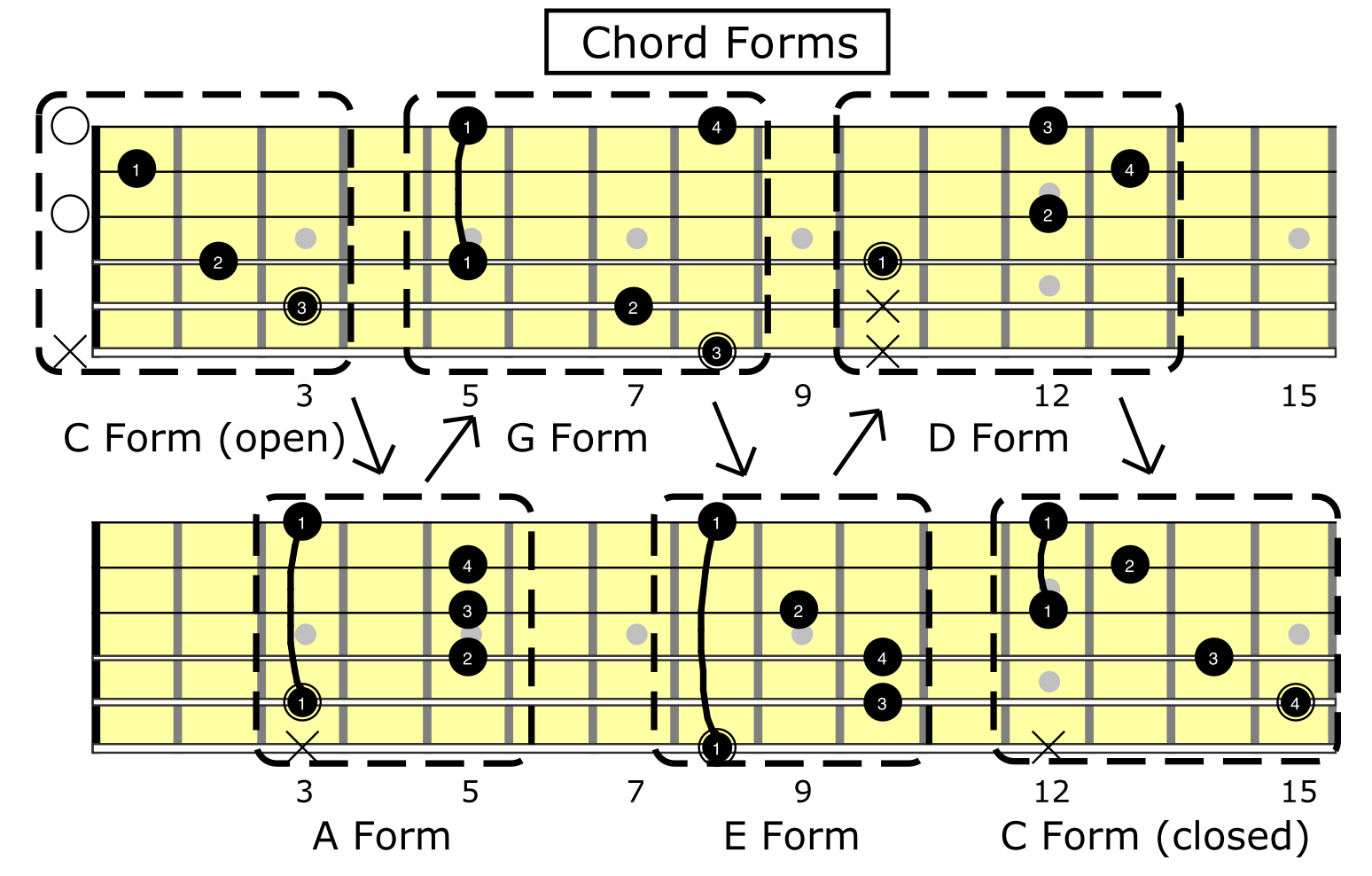Introduction to the CAGED System
Of all the ways of understanding the neck of the guitar, the CAGED system is one of the most widely-used, and from what I’ve seen, probably the most complete. It works in standard tuning (or any other tuning with the same intervals between the strings - like “C standard” for example), and can easily be adjusted for “drop” tunings, since only the 6th string is tuned differently.
The utility of the CAGED system lies in the way it connects chords and scales, and in the way it creates 5 categories (the “forms”) in which any chord or scale on the guitar can be placed.
The Forms
First, you must know the open chords C, A, G, E, and D. Any other chord voicing on the guitar can be understood as a variation of one of these 5 shapes. The first example of this comes from finding a way to play a C major chord at every position on the neck of the guitar. We start with the open C chord, which in the context of CAGED is called “C form of C.” The chord (the actual collection of notes, not particular to the guitar) is C, and the chord form is also C. If you then move your position to start where C form ends, you must use a barre chord to play C, and a little examination of this chord will show that it resembles the shape of an open A chord, but with a barre on the 3rd fret. We call this “A form of C.” The chord is C, and the chord form is A. Continuing this process up the neck, we find G form, E form, and D form. Put it together and it spells “CAGED” (Refer to diagram below).
Chords come from scales. A scale is a particular set of notes. A chord is another particular set of notes taken from a scale, played all at once (when you play the notes from a chord one at a time, this is an arpeggio). So, each of the chord forms comes from a scale form. We give the scale forms the same names as the chord forms (the first position in the key of C is called “C form”, etc.), and understand the difference largely by context. For example, if I say I’m using G form of C to play a particular melody, it’s understood that I’m talking about the scale form rather than the chord form. See the diagram below for the CAGED scale forms.
When you’re first learning the CAGED forms, you’ll want to use the following practice sequence for each one:
Play the chord form.
Play the entire scale form, ascending and descending.
Play the scale form starting on C (the circled note in the diagram) and ending on the next C (the next circled note). Once again, do this both ascending and descending. You’re playing one octave of the C major scale.
Play the chord form again.
Do this until you have memorized the 5 scale and chord forms.
Changing Keys
To play in a key other than C, you must move the forms to a location on the neck where the circled note is the tonic of the key you want to play in. For example, to play in the key of G, move the CAGED forms to where G is the circled note. They will all move together, still spelling “CAGED” repeatedly (e.g. GEDCAG in the key of G). When a form ends up in the open position (like G form of G), you may have to borrow notes from the next form to make it work, as you can’t go “backwards” from an open string. Figuring out these nuances for yourself will only strengthen your understanding of the forms.
Next Steps
Once you have memorized the forms and gotten comfortable moving them around to play in different keys, you will be able to “know the neck” at a basic level in any major key. Knowing some theory will help you see that you also have all the minor keys and the remaining 5 modes (Dorian, Phrygian, Lydian, Mixolydian, and Locrian). If you have not yet learned the necessary theory, there are many resources that can help you do so. (I am currently working on one of my own, so stay tuned!)
At this point, your journey has just begun! There is so much more to learn about the neck of the guitar using CAGED as a foundation. Simply knowing the shapes does not give you the ability to play with an awareness of the interactions between chord and melody. There are much deeper levels of understanding that CAGED can provide for you with continued study. I plan to develop more advanced online materials in the future, but if you really want to learn how all this works, I recommend taking some one-on-one lessons, whether in-person or online. Just contact me if you’re interested.
I hope this material helps your guitar playing. Remember to practice!
Note: My understanding of CAGED comes primarily from the years of lessons I took from Charlie Robinson. You can find a video of him explaining it here.

